|
|
| Construction safety |
|
I have joined a new company. I work in the building of an airport terminal.
So there I am, attached to a harness, dealing with guardrails and safety nets. |
|
|
|
|
| Evolving concepts |
|
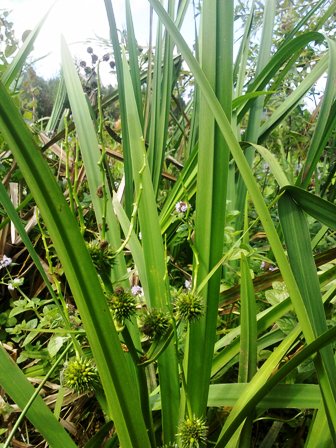
"Of Baranduin Brandywine seemed a natural corruption in modern times. Actually the older hobbit-name was Branda-nîn 'border-water',(...) but by a jest that had become habitual, referring again to its colour, at this time the river was usually called Bralda-hîm 'heady ale'." J.R.R. Tolkien. The Lord of the Rings. Appendix F, Note on Brandywine.
Evolving concepts
When we have to name new objects we borrow concepts from already-known items. Metaphor is the figure of speech applied. It is easier to explain with new technologies. The Internet for instance. The Web itself is a concept brought from nature as it visually reminds ourselves of an abstract image of a network. We surf the web because the amount of information is so huge that it is like sailing in a vast ocean. Also, when surfing you are only on the surface. A synecdoche, pars pro toto, emphasizes the huge amount of information available related to what we actually access: we think of the ocean not only as a flat sea but as a whole mass with its plunging depths.
A similar approach can be applied to explain some types of plants. The way we give names in reality comes from previous concepts: so for the Sparganium erectum we have both Portuguese espadana and Welsh cleddyflys with a lexeme meaning 'sword'. Another point is why do we highlight and how do we select different proprieties of a given object. Portuguese (so does the scientific name) focuses on the leaf, Welsh adds its fruit to the metaphoric shape-description. More prosaic English bur-reed buries its poetic roots and lets the bursting burr grow up until it distinguishes the wind-shaken spear plant! I very much like the German name Ästiger Igelkolben where I understand a homage is given to a voracious hedgehog!
This thorny mammal is another example of term-transfering by comparison as it has been metaphorically named after flora too: Portuguese ouriço cacho (Erinaceus europaeus) means literally 'a piece of burr'!
I?d better stop before I switch from smile to laughter thinking of Old Celtic for man (Homo sapiens) and a sapientior woman, both metamorphosed into an operosus donkey (Equus asinus) and a ludens magpie (Pica pica)! Semantics here would bring us to a new kingdom and... Romance!
|
|
|
|
|
| Tiles and bricks |
|
I have been traveling around Europe working with tiles and bricks for the last five months. Many thanks to all the kind people I have met these days at restaurants and hotels and at workplace. I have been at Kortrijk (Belgium), Varna (Bulgaria), Le Havre (France) and Madrid (Spain). My tasks ranged from the most basic (cleaning, carrying materials, preparing mortar) to the more elaborated of cutting tiles or building in-door brick walls.
I have not reached an agreement on the frequency of travels back home so I face myself with the difficult task of finding a job again. |
|
|
|
|
| Potato harvesting machines |
|
|
I spent most of the day repairing and improving the small potato harvesting machine. It has proved to be more efficient than the potato harvesting combine for these small, irregular, sloped, stony pieces of land.
In the morning I lubricated and repaired the bearings. In the afternoon dad and I began to place a new four-pinions shaft that has been designed to improve the machine performance. A local company manufactured it following the harvester particular requirements. At home we adjust the frame to fit the new component: metal cutting, screwing and welding.
|
|
|
|
|
| The turtle dove |
|
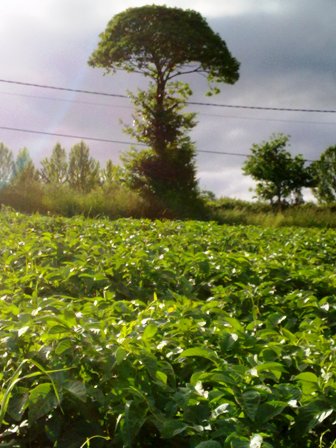
The sun shines over the potato cultivar that dad, mum and I planted the 10th of March. The plants have grown, leaves and branch stems have fully developed.
A prospection reveals that tubers have begun to grow above the ground too. This is the first crop of the year. The last potatoes of the season were planted two weeks ago.
I have been abroad for a month. Before I left I visited the old willow. So many years together and I realize now that it is a different hybrid from its neighbours: even if a little bit later than the rest, catkins have sprout too.
I came back on Saturday and I found the first foxgloves shining and dancing as if bells. I heard the turtle dove.
Here it announces the season for crops other than potatoes has arrived. |
|
|
|
|
| Ploughing again |
|
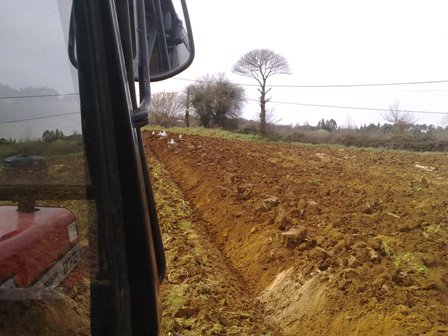
The willows have shown their catkins. Almost all them. An old one dwelling by the river I visited yesterday has shown none yet. We met many years ago when I was a young boy. I shall come back to the same place to see what is going on.
Meanwhile the first piece of a plot was ploughed today.
Instead of maneuvering the same way I did last year, this time more area is left unploughed towards the perimeter so turns are quicker and easier to be made.
I keep the line! |
|
|
|
|
| Support structure for kiwi vines (and IV) |
|
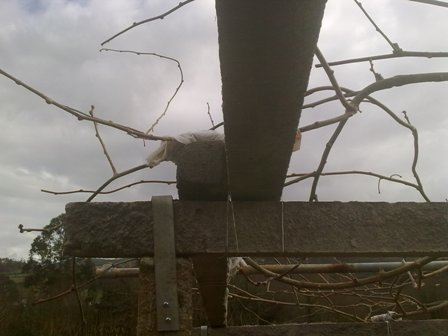
Fixing and finishing!
1. Steel strips 6 x 1 cm, 50 cm length are cut. Two holes bored on each side and finally U-bent to fit beam and pole on both sides.
2. Each beam is then fixed to the pole using screws.
3. Plant stems are left over the frame.
4. Contact surface is protected with textile (dust sheets here). |
|
|
|
|
| Support structure for kiwi vines (III) |
|
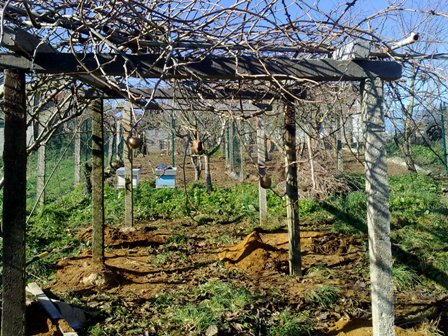
Support structure
1. Old structure (metal) is partially removed and picked up using a tractor.
2. Holes (40cm diameter, 90cm depth) are digged in 3 rows at a distance of 2m from one another.
3. Poles are leveled and retained with stones compacted with a sledgehammer. Finally some mud is added.
4. Beams brought up over the poles top.
5. Rafters over the beams. |
|
|
|
|
| Support structure for kiwi vines (II) |
|
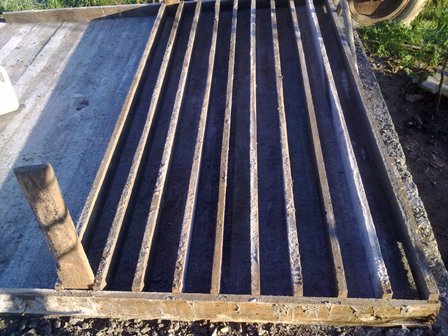
Formwork
Perhaps this process can be called casting indeed.
1. A mould is built out of lumber. Here I use units 2.5x10cm , 2.5m length.
2. A first layer of concrete is poured into, then rebars (10mm diameter) are dipped in. Finally another layer of concrete is poured until reaching the upper top of the mould.
3. I use no release agent: a higher level of roughness is expected, if too much I would apply a thin layer of mortar after deshuttering.
4. Left at least 20 days for curing. |
|
|
|
|
| Support structure for kiwi vines (I) |
|
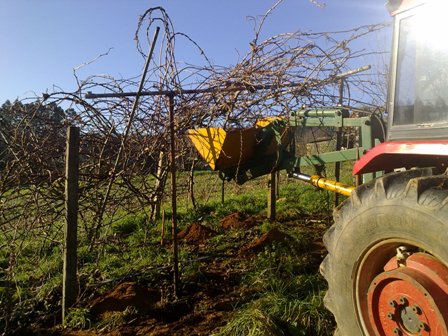
Some tools
Tape meter
Shovel
Concrete mixer
Hammer
Bubble level
Pincer
Angle grinder
Drill
A multi-function one: a tractor. This time a bucket is attached |
|
|
|
|
| Methinks |
|
Hello! After two weeks of non-stop work with tiles and floors I am back, resting. I got up late. I was alone at home. I greeted Rifante, spent some hours with the laundry, opening bank letters and the like and went to the town for a coffee.
I received Antye Greie's (www.poemproducer.com) latest album today, I am still listening to it. I have been at Abertal headquarters and felt a little bit of saudade of that time when I thought we could also contribute to change the world for the better. I came back home, sent some messages to say next Saturday I'll be walking close to the seashore, looking for the same places the bard sang. I switched on the iplayer tuned to my favourite program and finally surfed the web a little bit to find out this blog after a list from a friend at twitter: http://mittani.blogspot.com
I did not find an e-mail to write to the author. I would do so just to say I enjoyed the articles. Above all the one dealing with the expression methinks.
It is exactly the same in Galeg: eu parece-me. Quite common in old speakers, it is not that strange to hear it in Bergantinhos (Galizaland) even nowadays: we are dealing with an expression which has the same origin even if used in different languages: methinks, eu parece-me.
There is no sunlight. The night has arrived. However the birds are still singing: much more lively than usual. I feel the spring coming. Methinks. |
|
|
|
|
| Gusts in a kiwi's plot |
|
A storm, winds heavier than usual, and the weight of a good crop brought part of the support structure for the only two kiwi plants in the farm down to the soil. Kiwi is a new cultivar here.
A new structure is needed. It must support not only the weight of the crop but tension that could be carried over by strong winds: when the kiwi plants grow, stems and leaves form an almost homogeneous cover that offers resistance to the wind as a whole and thus acts upon the frame.
There are several solutions. Metallic or polymeric bars could be intercrossed and fastened. In fact steel bars formed the previous frame. However there are not low-cost ready-to-use easy-to-install products available. Timber offers less durability. Given the know-how and tools at hand I regard any of the materials as equally time-consuming.
Concrete offers a more resistant frame, good performance and longer life-span. I would not consider it if there were many plants, as transport, time and difficulty of construction would favour any of the previously mentioned materials: even if not as much resistant, they are effective enough for what uses to be even the most common heavier winds of the area. And once the frame is set up, if replacement units are left, it would be easy to mend or to replace if any element got damaged.
I prefer stone as a visible surface in this environment. There could be polymers, even steel bars with much more thinner section, that offer less visual impact than concrete, however they lack the appearance stone or wood show. Anyway the plants are going to hide most of the frame, and thus any aesthetic features of the frame itself would be minimized. As far as I have seen in traditional vine supports, squared stone is used for the posts. In terms of shape the most similar appearance would be that offered by concrete. More: I can favour a rough look more similar to that of stone avoiding a release agent over the shuttering. Texture remains that of concrete. However, even if it could take some years and does not hide concrete appearance completely, roughness rises a microhabitat for moss to grow in these rainy lands.
Anyway I can apply a finishing if needed. In fact some buildings of the farm require to be covered with stone.
Suggestions about concrete and finishings over concrete are welcome.
|
|
|
|
|
|
|
|
